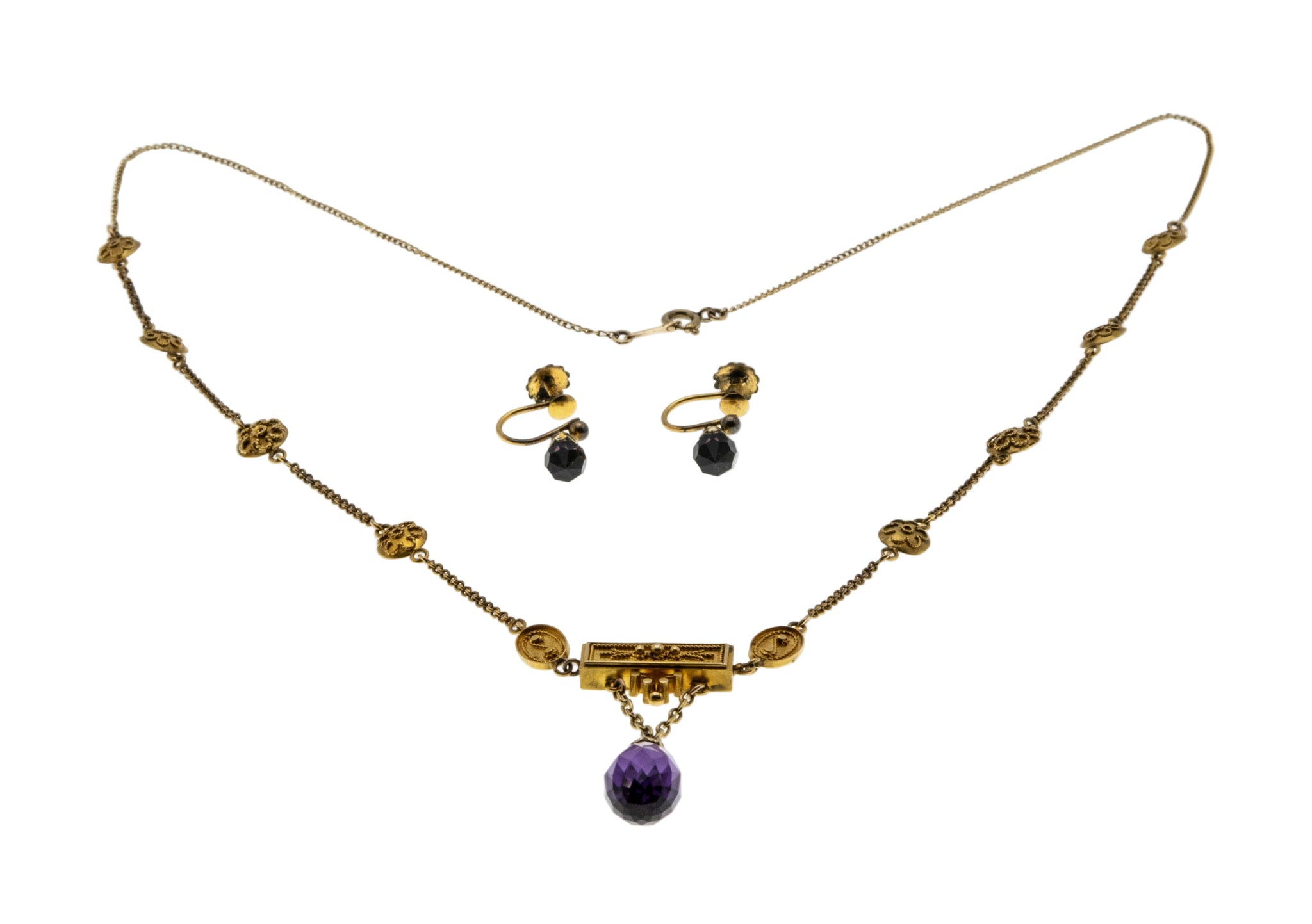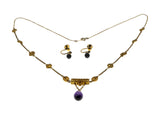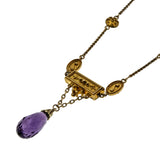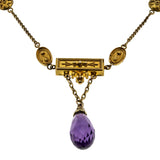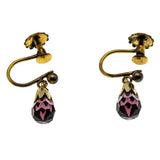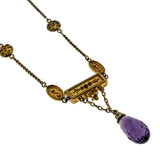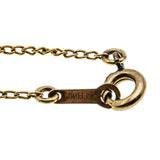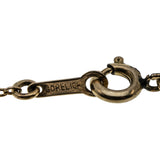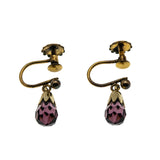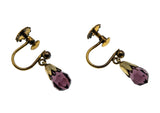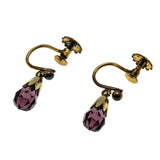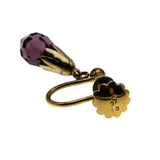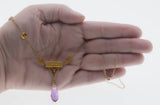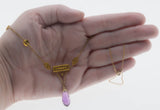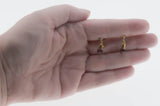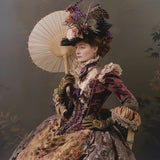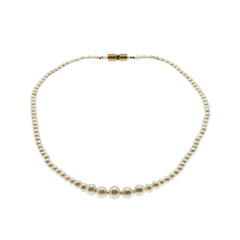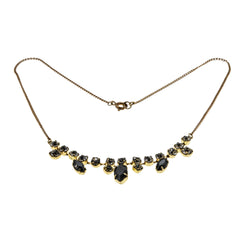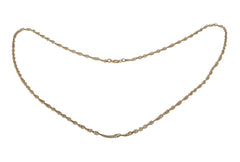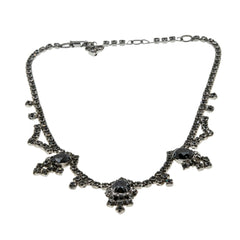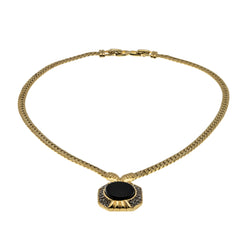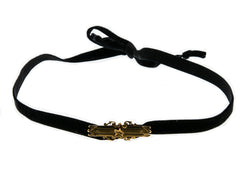Etruscan Revival - Victorian English 9K/10K/14K Gold Natural Amethyst Briolette Necklace & Screw-Back Earrings Set (VICN060)
Rarities Antique Jewelry
Etruscan Revival - Victorian English 9K/10K/14K Gold Natural Amethyst Briolette Necklace & Screw-Back Earring Set. This exquisite set is masterfully crafted in 9K/10K, and 14K gold, tested, and confirmed, and a makers mark GOREL. The set features 3 natural faceted amethyst briolettes, Victorian era Etruscan Revival styling, and high quality craftsmanship. This antique set is comprised of a necklace, which showcases a beautiful decorated central plaque, and chains, which suspends a beautiful purple amethyst drop, displaying purplish violet hues. The chain is a belcher design, and longer than most often seen in other Victorian examples. The chain is interspaced by wonderful round discs of gold, which are decorated with a delicate fine twisted rope design. The earrings are crafted in 10K gold, whilst the findings are gold filled. This rare victorian Etruscan Revival set is truly a treasure to be cherished and enjoyed from times past. Artistic and glorious.
Comments: A wonderful fine example of Victorian Etruscan Revival jewelry set. Natural amethyst briolettes are fabulous.
Note: Contemporary appraisals do not reflect the value of antique jewelry. This Victorian set should be insured for $5000.00 CD (Tax Excluded)
History: Ancient Greeks and Romans believed this gemstone could ward off the intoxicating powers of Bacchus and keep the wearer clear-headed and quick-witted. English regalia were decorated with amethysts during the Middle Ages to symbolize royalty. Amethyst jewelry has been found and dated as early as 2000 BC.
Gold was generally used for a couple thousand years solely to create things such as jewelry and idols for worship. This was until around 1500 BC when the ancient empire of Egypt, which benefited greatly from its gold-bearing region, Nubia, made gold the first official medium of exchange for international trade.
Etruscan revival jewellery is an ornate style of jewellery that became highly fashionable in the 19th century. It was inspired by the intricate designs and techniques of the ancient Etruscans in what is now modern-day Italy between the 8th and 3rd centuries BC. Although the Romans are commonly seen as the greatest power of the ancient world, many of the sophisticated innovations such as canals, roads and grid-planned cities credited to them were, in fact, of Etruscan origin.
The Etruscan Revival movement was sparked by archaeological discoveries made in the early 19th century. Excavations in Italy, particularly in Etruria (modern-day Tuscany), unearthed a wealth of ancient artefacts, including exquisite gold jewellery which was often buried with the deceased. These findings captivated the imagination of the public, leading to a resurgence of interest in Etruscan art and influencing other areas of design, including architecture, furniture, and decorative arts.
Etruscan Revival jewellery is characterized by detailed motifs like animals, leaves, and faces on brooches, rings, necklaces, bracelets, as well as Parures which are complete sets of matching items. While the ancient Etruscans often used gemstones in their jewellery, the revival pieces incorporated both precious and semi-precious stones. Garnets, agates, and chalcedony were among the popular choices, adding colour and brilliance to the gold settings. The use of stars as a motif illustrates the incorporation of Victorian tastes, and so Etruscan Revival jewellery is often regarded as a fusion between Etruscan and Victorian design.
Nobility and the wealthy commissioned jewellery from makers such as Alessandro Castellani (1823-83), who honed the technique of granulation, the placing of tiny balls of precious metal on the surface of a piece creating texture. Another popular technique was that of filigree, the art of twisting fine gold or metal wire soldered together or laid on to the surface of the metal to create pattern. Credited with reviving goldsmithing practices from the ancient world, Castellani’s jewellery was much copied by others at the time, and his original pieces are highly sought after now.
Etruscan Revival jewellery’s popularity with the Victorians was a blend of history and craftsmanship, with a focus on highly detailed, sculptural designs. The jewellery is still popular and wearable today and there is a vibrant collectors’ market for pre-loved and heirloom pieces.
Most Etruscan Revival Victorian Jewelry was made in Italy, particularly by Italian artisans like Fortunato Pio Castellani, who was known for resurrecting the original techniques and creating many of the initial reproductions. However, because the style became a major trend, it was also produced in other centers, notably London, which boasted great prosperity and innovation during the Victorian era.
-
Technique and Style:Look for detailed granulation, intricate filigree (fine gold wire), and other ornamental techniques characteristic of the Etruscan revival.
Hallmarks:Check for British hallmarks or other marks that might indicate where the piece was made. Although many pieces from this time are not marked.
Materials:Pieces could be made from gold or silver, sometimes gold-plated, and often featured natural gemstones, enamel, or glass.
Victorian Etruscan Revival jewelry was made during the height of the Victorian era, particulary from the mid-1850s to the mid-1880s. This style became popular after the discovery of ancient Etruscan tombs and was championed by jewelers like Italian goldsmith Alessandro Castellani, who recreated ancient techniques such as granulation, filigree, and ornate gold
In the history of the United Kingdom and the British Empire, the Victorian era was the reign of Queen Victoria, from 20 June 1837 until her death on 22 January 1901. Slightly different definitions are sometimes used.
Measurements: Necklace 24" Drop: 42.00 mm x 18.50 mm Earrings : 18.00 mm x 5.50 mm
Stone Size: Amethyst 15.00 carats (approximately) restrictions due to settings.
Weight: 11.88 grams
Condition: Excellent
Origin: England
Date: Circa 1865

